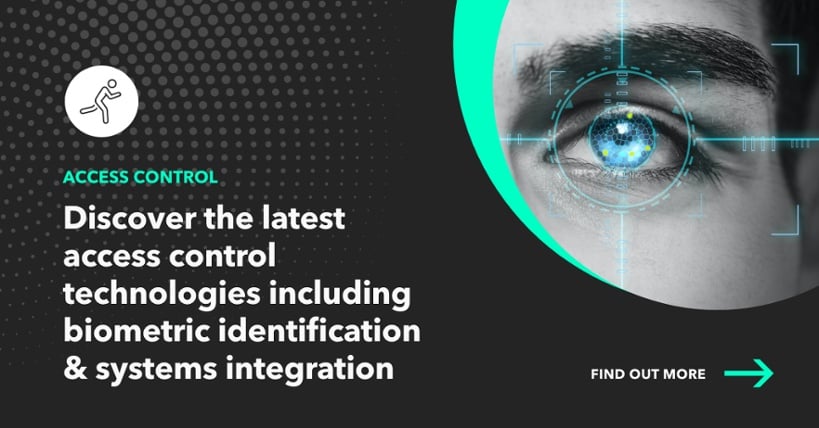It was once technology only used within secure military installations or feverishly imagined in science fiction movies. Fingerprint entry, retinal scans and facial recognition, data that could unlock doors and give access to deep state secrets. Has biometric access control now come of age? Here are 9 reasons why you should take notice.
9 reasons Biometric Access Control has come of age
1. Biometrics is the ultimate secure entry mechanism
Fobs and keys can be stolen and lost. Even mobile credentials can potentially be hacked, compromised and misused. But biometrics are unforgeable and unforgettable. Used as part of an access control system they can give building managers complete confidence about exactly who is in a building - the ultimate in identity authentication.
2. It works
Fingerprint, and retina scanning traditionally have the lowest FRR (False rejection rate and FAR (False Acceptance rate) of all the biometric entry systems. However, the reliability of facial recognition technology (FRT) has been catching up rapidly. In NIST's 2020 tests, the best facial identification algorithm had an error rate of just 0.08%. But faced with the added challenge of mask detection and a big increase in the use of facial recognition tech for Covid safe entry - the tech has made even bigger and faster strides in accuracy in 2021:
“Firms have raced to update their algorithms so that they can cope with masks, especially in situations where facial recognition is used to confirm someone's identity - such as authorising access to a secure building… An updated report from NIST has now found that several algorithms, reconfigured since the pandemic began, make far fewer mistakes when analysing masked faces. In some cases, error rates were ten times better than before.”
3. It has realised the dream of a more secure, contactless office
Biometric solutions are ditching the need to maintain and distribute expensive fob and entry cards. At the same time, they’re cutting the risk of unauthorised entry to practically zero. As well as rock solid identity authentication, biometric access control offers more sophisticated tailgating protections, too. In the Covid crisis, facial recognition technology has made it safer and easier for workers to move around buildings at will without the need to touch door handles or press entry buttons - while still keeping buildings secure.
4. Covid has also demonstrated how facial recognition can work in tandem with other biometric data.
Real-time ‘fever screening’ linked with FRT and access control systems allowed companies to identify workers with elevated temperatures and prevent them from entering buildings. The tech also was able to contribute to internal ‘track and trace’ efforts alerting individuals when they were in contact with suspected Covid cases. With the frequency of pandemics likely to increase, being able to ‘switch on’ this kind of functionality at will may become increasingly important.
5. It can transform our capacity for agile working
For many companies Covid has proved how biometrics can be leveraged for touchless office access. Now, as we return to offices in more agile working mode, embracing hybrid work models and ‘hub and spoke’ office arrangements this flexibility has never been more important. The opportunity is to transform our buildings into secure yet frictionless spaces that intuitively ‘open up’ for workers as they move through the day.
6. Workers want it
Are workers resistant to the use of biometrics? Research into attitudes around the use of this technology show that younger people are accepting of their use, particularly if they can see the benefits to the quality of their working lives:
75% OF 16 TO 24-YEAR-OLDS, OR ‘GENERATION Z’, SAY THEY WOULD HAVE NO PROBLEM USING BIOMETRIC SECURITY IF IT MAKES THEIR LIVES EASIER
7. The technology is here
As we’ve seen, the technology is here. It is accurate, dependable and, critically, can be integrated with other systems. From thermal imaging, to security, building management and HR applications, biometric access control systems can gather all kinds of data and talk to different systems to become part of a powerful ‘smart office’ network.
8. The price is right
Not only is the tech available but it is accessible at increasingly reasonable prices. Covid has increased interest and take-up of the technology, which in turn has led to rapid improvements in accuracy and more compelling pricing options.
9. More is possible
Biometric access control systems can be used to collect data to make our working environments more anticipatory, interactive and caring. How about sensors that track the facial expressions, gait and pace of workers entering a building? In some companies they are being used to feed into company-wide wellness metrics and even support HR interventions. Or is that a bridge too far?
Many of the traditional obstacles to biometric access control such as concerns over privacy, expense and reliability have been superseded by the Covid era’s urgent need for more contactless entry solutions. At the same time, there have been improvements in accuracy and our everyday experience of the tech is fuelling wider acceptance and adoption.
As you consider your options for delivering more frictionless working experiences and smarter building management it’s likely that you will be encountering biometrics as an increasingly viable and compelling alternative to card or mobile-powered solutions.





 Previous Blog
Previous Blog

Comments.